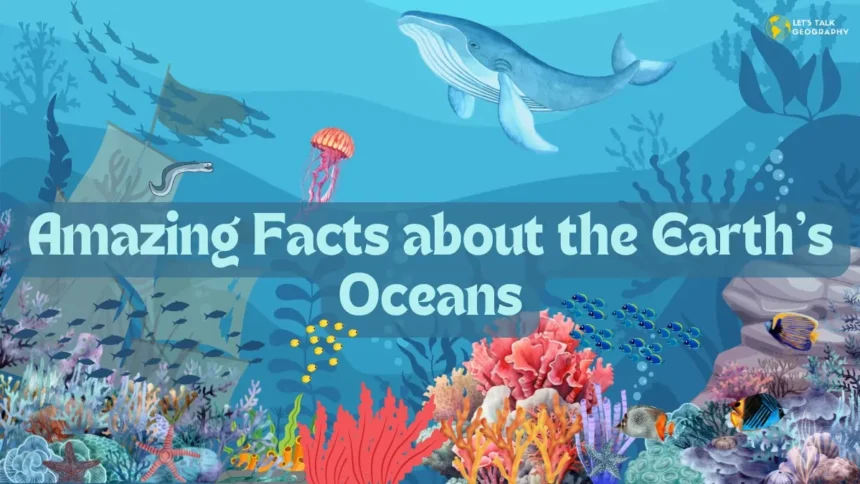Introduction:
Have you ever wondered how much of our planet is covered by oceans? Or what mysteries lie beneath their surface? Earth’s oceans are vast, covering 71% of its surface, yet much of their depths remain unexplored. From incredible marine life to the powerful currents that drive our weather, oceans play a critical role in sustaining life on Earth. They are home to some of the most awe-inspiring phenomena and unknown wonders that continuously captivate scientists and explorers alike.
This article will explore 10 amazing facts about the Earth’s oceans. These fun and surprising facts will help us appreciate the oceans’ critical role and the incredible secrets they still hold. Let’s explore the blue wonders of our world!
Read also: Coral Reef Food Webs: A Fascinating Guide to the Ocean’s Ecosystem
1. Oceans Cover More Than 70% of the Earth’s Surface
Overview: One of the most amazing facts about the Earth’s oceans is that they cover approximately 71% of its surface. That means most of our planet is underwater, leaving only about 29% of the Earth’s surface for land!
- Key Fact: Despite the oceans’ vast expanse, humans have only explored about 5% of them.
- Fun Fact: The Pacific Ocean is the largest, covering more area than all the landmasses combined.
Why It’s Amazing: The sheer size of the oceans makes them one of the most critical components of Earth’s ecosystem, influencing everything from climate to the water cycle.
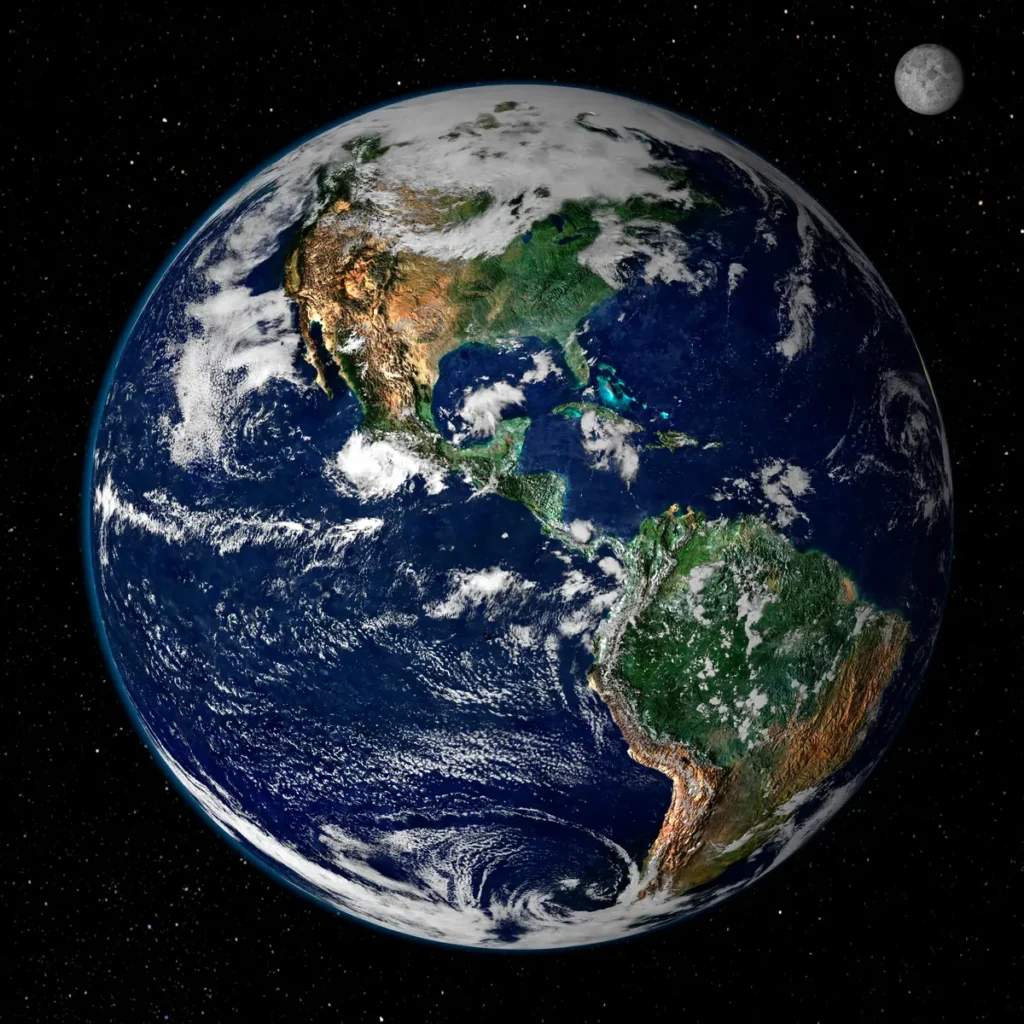
2. The Oceans Contain Over 90% of the Earth’s Living Space
Overview: While most life forms live on land, oceans hold most of the planet’s habitable space. Marine life thrives in various extreme environments, from the shallow waters near the coast to the deep ocean trenches.
- Key Fact: Deep-sea ecosystems are some of the least understood environments on Earth, and many new species are discovered each year.
- Fun Fact: The oceans provide habitat for nearly 230,000 known species, but scientists believe millions more are waiting to be discovered.
Why It’s Amazing: Earth’s oceans offer diverse and rich ecosystems that support more species than all of Earth’s terrestrial ecosystems.
Read also: Marine Food Web: 5 Threats to the Backbone of the Oceans
3. The Deepest Part of the Ocean Is the Mariana Trench
Overview: The Mariana Trench, located in the Pacific Ocean, is the deepest part of the Earth’s oceans, plunging to about 36,000 feet— deeper than Mount Everest is tall!
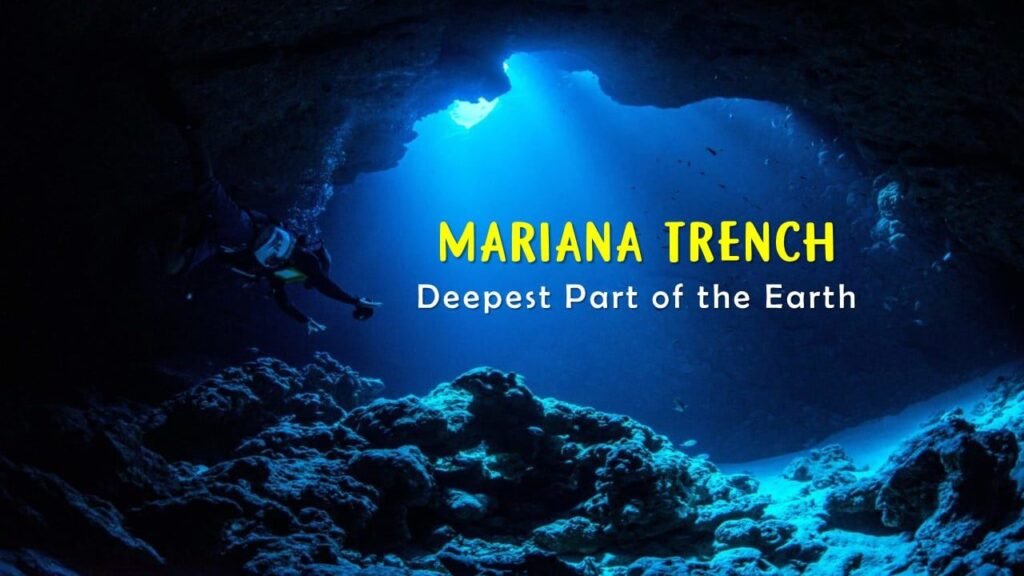
- Key Fact: The trench is near Guam and extends over 1,500 miles.
- Fun Fact: The pressure at the bottom of the trench is over 1,000 times greater than at sea level, making it one of the most extreme environments on Earth.
Why It’s Amazing: The Mariana Trench is so deep that it has remained largely unexplored, and it’s believed that many undiscovered species could thrive in its depths.
Read also: Mariana Trench – The Deepest Part of the World
4. Oceans Regulate the Earth’s Climate
Overview: Earth’s oceans play a crucial role in regulating the global climatic pattern by absorbing and distributing heat around the globe. They also store carbon dioxide and release oxygen, creating a more balanced atmosphere.
- Key Fact: Oceans absorb about 93% of the heat greenhouse gases trap.
- Fun Fact: Ocean currents, such as the Gulf Stream, transport warm water from the equator toward the poles, affecting weather patterns and temperature.
Why It’s Amazing: Without the ocean’s ability to regulate heat and gases, Earth’s climate would be far more extreme, making life as we know it impossible.
Read also: How Ocean Currents Affect Climate: Unveiling the Ocean’s Powerful Weapon in 5 Ways
| Fact | Key Information |
| Oceans cover 71% of the Earth | 71% of Earth’s surface is ocean, but only 5% is explored |
| Oceans contain 90% of Earth’s living space | Oceans house the majority of Earth’s ecosystems |
| The deepest part is the Mariana Trench | Depth of 36,000 feet |
| Oceans regulate Earth’s climate | Absorbs 93% of excess heat and carbon dioxide |
| Five interconnected oceans | Pacific, Atlantic, Indian, Southern, Arctic |
| Great Barrier Reef is largest living structure | 1,400 miles long, home to thousands of species |
| 97% of Earth’s water is in the oceans | Only 3% is freshwater |
| Oceans produce over 50% of Earth’s oxygen | Phytoplankton are the primary oxygen producers |
| Underwater lakes and rivers exist | It is found in areas with high salinity, like the Gulf of Mexico |
| Oceans are becoming more acidic | Oceans absorb 30% of carbon dioxide emissions |
5. There Are Five Oceans, but They’re All Connected
Overview: While we often talk about the Pacific, Atlantic, Indian, Southern, and Arctic Oceans as separate entities, they are all interconnected, forming one massive global ocean system.
- Key Fact: The Pacific Ocean is the largest, covering over 63 million square miles, while the Arctic Ocean is the smallest, covering about 5 million square miles.
- Fun Fact: The Southern Ocean was only officially recognized by the International Hydrographic Organization in 2000.
Why It’s Amazing: This interconnected system of oceans plays a vital role in global ocean currents, which drive weather patterns and support the marine food chain.
Read also: Fascinating Mechanics of Major Ocean Currents of The World: How They Move and Affect Us
6. The Oceans Are Home to the Largest Living Structure on Earth
Overview: The Great Barrier Reef, located off the coast of Australia, is the largest living structure on the planet. This coral reef system stretches over 1,400 miles and is visible from space.
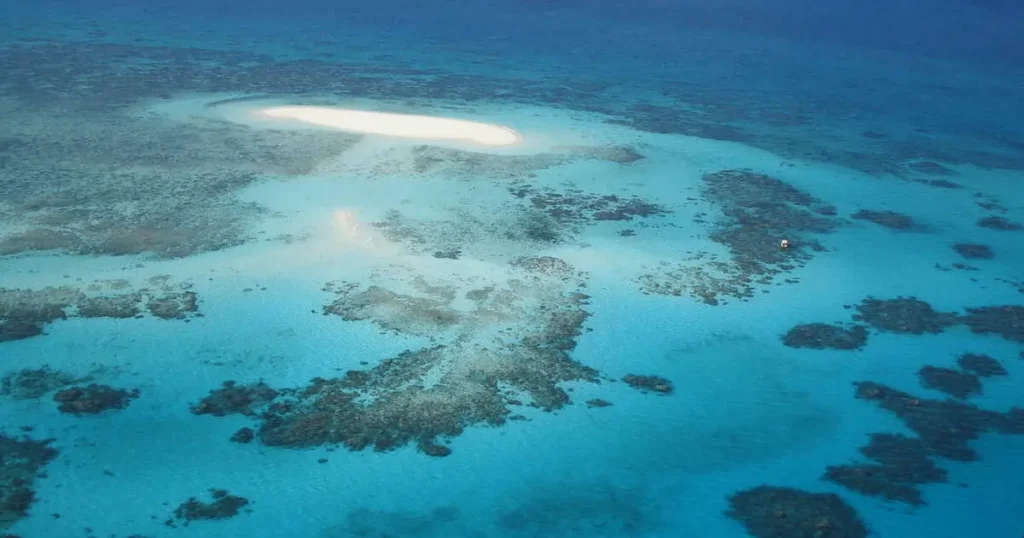
- Key Fact: The Great Barrier Reef comprises nearly 3,000 individual reefs and is home to thousands of species of marine life.
- Fun Fact: Coral reefs cover less than 1% of the ocean floor but support 25% of all marine species.
Why It’s Amazing: The Great Barrier Reef’s biodiversity and sheer scale make it one of the most unique ecosystems on Earth. It also highlights the importance of conserving marine habitats.
Read also: 6 Reasons Why Is the Great Barrier Reef Important?
7. The Oceans Hold 97% of the Earth’s Water
Overview: It might surprise you that nearly 97% of Earth’s water is contained in the oceans, with only a tiny fraction—around 3%—found in glaciers, rivers, lakes, and underground reservoirs.
- Key Fact: Of the 3% of Earth’s freshwater, about 2% is locked in glaciers and ice caps.
- Fun Fact: If all the salt in the oceans were removed and spread evenly across the Earth’s land surface, it would form a layer about 500 feet deep!
Why It’s Amazing: Oceans are the primary source of the planet’s water, making them critical to Earth’s hydrological cycle and essential for all life forms.
Read also: Ocean Relief: 7 Spectacular Features That Shape Our Oceans
8. The Oceans Produce More Oxygen Than All of the World’s Forests Combined
Overview: Oceans are a powerhouse of oxygen production, thanks to tiny marine organisms called phytoplankton. These microscopic plants perform photosynthesis, releasing oxygen into the atmosphere.
- Key Fact: Phytoplankton produce over 50% of the world’s oxygen supply.
- Fun Fact: One liter of seawater can contain 1 million phytoplankton!
Why It’s Amazing: Many people consider forests the primary source of oxygen, but the oceans provide more than half of the oxygen we breathe.
Another amazing fact about the Earth’s oceans is that they act as ‘Carbon Sinks’ and balance global oxygen and carbon dioxide levels.
Read also: 4 Critical Impacts of Phytoplankton on Global Climate: Unraveling the Ocean’s Microscopic Guardians
9. There Are Underwater Lakes and Rivers in the Ocean
Overview: It sounds like science fiction, but there are actual underwater lakes and rivers at the bottom of the ocean! These occur when dense layers of saltwater form in depressions, creating distinct “lakes” on the ocean floor.
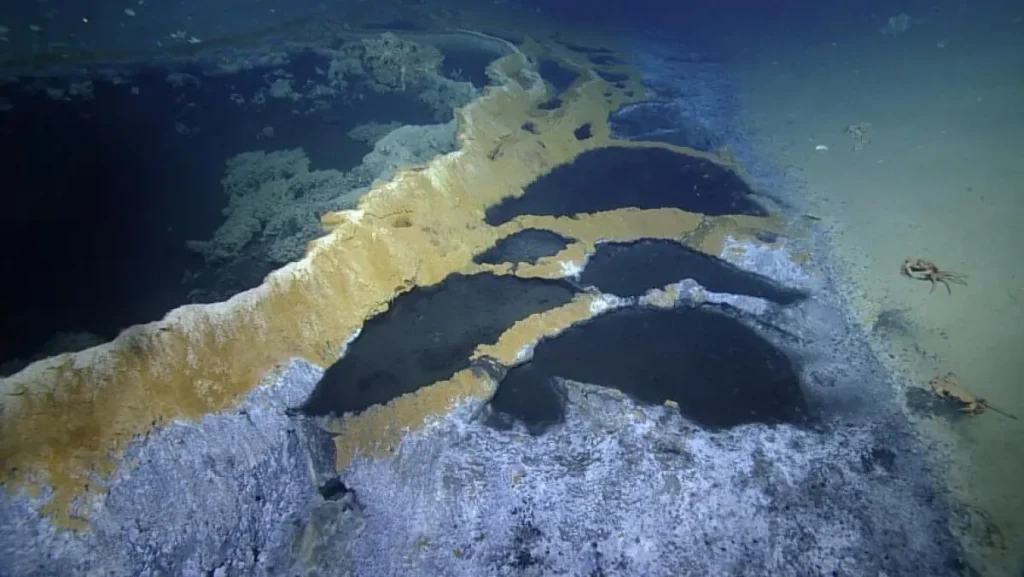
- Key Fact: These underwater lakes are found in areas with high salinity, like the Gulf of Mexico, and can be up to 60 feet deep.
- Fun Fact: The borders of these lakes often have “shorelines” that resemble those on land, with waves, beaches, and even tides.
Why It’s Amazing: Underwater lakes and rivers are so alien in appearance that they’re often compared to extraterrestrial landscapes, adding to the mystery of the deep sea.
Read also: Seafloor Spreading: 3 Strange Facts About the Ocean Floor
10. The Oceans Are Becoming More Acidic
Overview: Human activities, such as the burning of fossil fuels, are absorbing more carbon dioxide, which causes ocean acidification. This change in the ocean’s chemistry threatens marine life, especially creatures with calcium carbonate shells like coral and some shellfish.
- Key Fact: Earth’s oceans absorb about 30% of the carbon dioxide released into the atmosphere.
- Fun Fact: Ocean acidification has increased by 26% since the start of the Industrial Revolution.
Why It’s Amazing: Ocean acidification is one of the lesser-known impacts of climate change, but its effects could devastate marine ecosystems and the humans who depend on them.
Read also: Ocean Acidification: Unveiling the Hidden Crisis Threatening Marine Life
Conclusion
In conclusion, the Earth’s oceans are vast, mysterious, and essential to life. From covering 71% of the Earth’s surface to hosting the deepest points and influencing climate, the oceans play a vital role in maintaining global balance. Despite their importance, much of the ocean remains unexplored, offering endless opportunities for discovery. Understanding the amazing facts about the Earth’s oceans, underwater lakes, and rivers helps us appreciate their significance and encourages their protection. As we continue to uncover their secrets, the Earth’s oceans remain one of its greatest wonders. Stay curious and explore the amazing facts about the Earth’s oceans.
FAQs
1. What percentage of the Earth’s surface is covered by oceans?
Oceans cover approximately 71% of the Earth’s surface, making them the largest ecosystem on the planet, vital for life, weather patterns, and biodiversity.
2. How many oceans are there, and what are their names?
There are five oceans: the Pacific, Atlantic, Indian, Southern, and Arctic. Together, they form a continuous global body of saltwater.
3. What is the deepest point in the Earth’s oceans?
The Mariana Trench in the Pacific Ocean is the deepest point, with its Challenger Deep reaching about 36,000 feet (11,000 meters) below sea level.
4. How do oceans influence Earth’s climate?
Oceans regulate Earth’s climate by absorbing heat, distributing it through currents, and releasing moisture into the atmosphere, influencing weather patterns worldwide.
5. What is the significance of ocean currents?
Ocean currents regulate global climate by distributing heat and nutrients, driving weather systems, and supporting marine ecosystems.
6. How much of the ocean remains unexplored?
More than 80% of the ocean remains unexplored. Due to technological limitations, vast areas of the ocean’s depths and ecosystems are still unknown.


